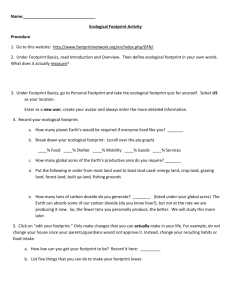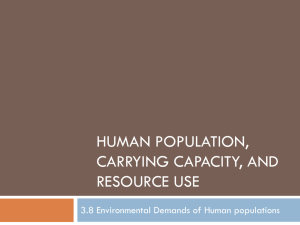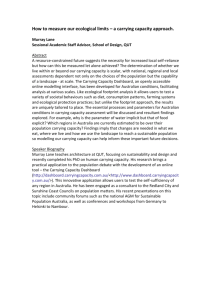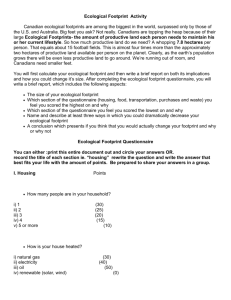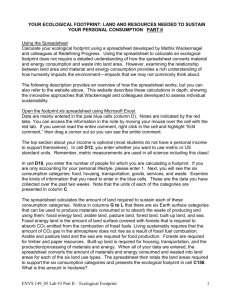Ecological Footprint Activity
advertisement
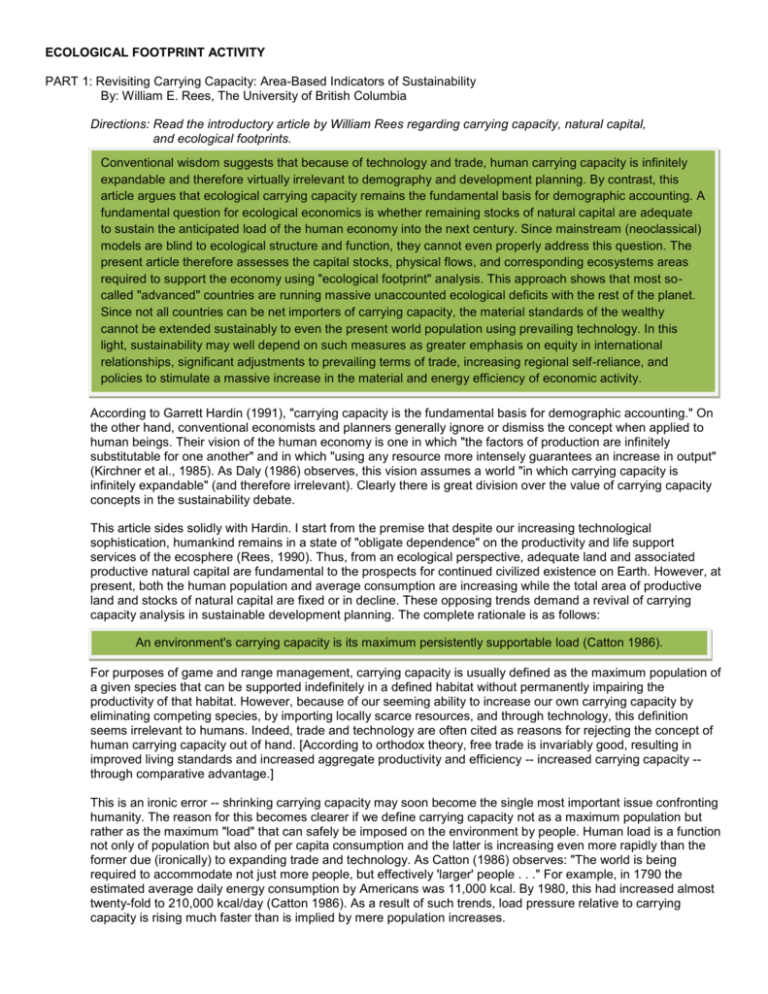
ECOLOGICAL FOOTPRINT ACTIVITY PART 1: Revisiting Carrying Capacity: Area-Based Indicators of Sustainability By: William E. Rees, The University of British Columbia Directions: Read the introductory article by William Rees regarding carrying capacity, natural capital, and ecological footprints. Conventional wisdom suggests that because of technology and trade, human carrying capacity is infinitely expandable and therefore virtually irrelevant to demography and development planning. By contrast, this article argues that ecological carrying capacity remains the fundamental basis for demographic accounting. A fundamental question for ecological economics is whether remaining stocks of natural capital are adequate to sustain the anticipated load of the human economy into the next century. Since mainstream (neoclassical) models are blind to ecological structure and function, they cannot even properly address this question. The present article therefore assesses the capital stocks, physical flows, and corresponding ecosystems areas required to support the economy using "ecological footprint" analysis. This approach shows that most socalled "advanced" countries are running massive unaccounted ecological deficits with the rest of the planet. Since not all countries can be net importers of carrying capacity, the material standards of the wealthy cannot be extended sustainably to even the present world population using prevailing technology. In this light, sustainability may well depend on such measures as greater emphasis on equity in international relationships, significant adjustments to prevailing terms of trade, increasing regional self-reliance, and policies to stimulate a massive increase in the and energy efficiency of economic activity. Whymaterial Carrying Capacity? According to Garrett Hardin (1991), "carrying capacity is the fundamental basis for demographic accounting." On the other hand, conventional economists and planners generally ignore or dismiss the concept when applied to human beings. Their vision of the human economy is one in which "the factors of production are infinitely substitutable for one another" and in which "using any resource more intensely guarantees an increase in output" (Kirchner et al., 1985). As Daly (1986) observes, this vision assumes a world "in which carrying capacity is infinitely expandable" (and therefore irrelevant). Clearly there is great division over the value of carrying capacity concepts in the sustainability debate. This article sides solidly with Hardin. I start from the premise that despite our increasing technological sophistication, humankind remains in a state of "obligate dependence" on the productivity and life support services of the ecosphere (Rees, 1990). Thus, from an ecological perspective, adequate land and associated productive natural capital are fundamental to the prospects for continued civilized existence on Earth. However, at present, both the human population and average consumption are increasing while the total area of productive land and stocks of natural capital are fixed or in decline. These opposing trends demand a revival of carrying capacity analysis in sustainable development planning. The complete rationale is as follows: An environment's carrying capacity is its maximum persistently supportable load (Catton 1986). For purposes of game and range management, carrying capacity is usually defined as the maximum population of a given species that can be supported indefinitely in a defined habitat without permanently impairing the productivity of that habitat. However, because of our seeming ability to increase our own carrying capacity by eliminating competing species, by importing locally scarce resources, and through technology, this definition seems irrelevant to humans. Indeed, trade and technology are often cited as reasons for rejecting the concept of human carrying capacity out of hand. [According to orthodox theory, free trade is invariably good, resulting in improved living standards and increased aggregate productivity and efficiency -- increased carrying capacity -through comparative advantage.] This is an ironic error -- shrinking carrying capacity may soon become the single most important issue confronting humanity. The reason for this becomes clearer if we define carrying capacity not as a maximum population but rather as the maximum "load" that can safely be imposed on the environment by people. Human load is a function not only of population but also of per capita consumption and the latter is increasing even more rapidly than the former due (ironically) to expanding trade and technology. As Catton (1986) observes: "The world is being required to accommodate not just more people, but effectively 'larger' people . . ." For example, in 1790 the estimated average daily energy consumption by Americans was 11,000 kcal. By 1980, this had increased almost twenty-fold to 210,000 kcal/day (Catton 1986). As a result of such trends, load pressure relative to carrying capacity is rising much faster than is implied by mere population increases. The Ecological Argument Despite our technological, economic, and cultural achievements, achieving sustainability requires that we understand human beings as ecological entities. Indeed, from a functional perspective, the relationship of humankind to the rest of the ecosphere is similar to those of millions of other species with which we share the planet. We depend for both basic needs and the production of artifacts on energy and material resources extracted from nature and all this energy/matter is eventually returned in degraded form to the ecosphere as waste. The major material difference between humans and other species is that in addition to our biological metabolism, the human enterprise is characterized by an industrial metabolism. In ecological terms, all our toys and tools (the "capital" of economists) are "the exosomatic equivalent of organs" (Sterrer, 1993) and, like bodily organs, require continuous flows of energy and material to and from "the environment" for their production and operation. It follows that in a finite world: Economic assessments of the human condition should be based on, or at least informed by, ecological and biophysical analyses. The appropriate ecological analyses focus on the flows of available energy/matter (essergy) particularly from primary producers--green plants and other photosynthesizers -- to sequential levels of consumer organisms in ecosystems (specifically, humans and their economies) and on the return flows of degraded energy and material (wastes) back to the ecosystem. This approach shows that humankind, through the industrial economy, has become the dominant consumer in most of the Earth's major ecosystems. We currently "appropriate" 40% of the net product of terrestrial photosynthesis (Vitousek et al., 1986) and 25-35% of coastal shelf primary production (Pauly & Christensen, 1995), and these may be unsustainable proportions. [Global fisheries yields have fallen since 1989.] At the same time some global waste sinks seem full to overflowing. A fundamental question for ecological economics, therefore, is whether the physical output of remaining species populations, ecosystems, and related biophysical processes (i.e., critical self-producing natural capital stocks – see Box 1), and the waste assimilation capacity of the ecosphere, are adequate to sustain the anticipated load of the human economy into the next century while simultaneously maintaining the general life support functions of the ecosphere. This "fundamental question" is at the heart of ecological carrying capacity but is virtually ignored by mainstream analyses. Box 1: On Natural Capital Natural capital refers to "a stock [of natural assets] that yields a flow of valuable goods and services into the future." For example, a forest or a fish stock can provide a flow or harvest that is potentially sustainable year after year. The stock that produces this flow is " natural capital" and the sustainable flow is "natural income." Natural capital also provides such services as waste assimilation, erosion and flood control, and protection from ultra-violet radiation (the ozone layer is a form of natural capital). These life support services are also counted as natural income. Since the flow of services from ecosystems often requires that they function as intact systems, the structure and diversity of the system may be an important component of natural capital. There are three broad classes of natural capital: Renewable natural capital, such as living species and ecosystems, is self-producing and self-maintaining using solar energy and photosynthesis. These forms can yield marketable goods such as wood fibre, but may also provide unaccounted essential services when left in place (e.g., climate regulation). Replenishable natural capital, such as groundwater and the ozone layer, is non-living but is also often dependent on the solar "engine" for renewal. Finally, non-renewable natural capital such as fossil fuel and minerals, are analogous to inventories - any use implies liquidating part of the stock. This article takes the position that since adequate stocks of self-producing and replenishable natural capital are essential for life support (and are generally non-substitutable), these forms are more important to sustainability than are non-renewable forms. Source: Rees (1995), liberally adapted from Costanza and Daly (1992). Appropriated Carrying Capacity and Ecological Footprints We can now redefine human carrying capacity as the maximum rates of resource harvesting and waste generation (the maximum load) that can be sustained indefinitely without progressively impairing the productivity and functional integrity of relevant ecosystems wherever the latter may be located. The size of the corresponding population would be a function of technological sophistication and mean per capita material standards (Rees, 1988). This definition reminds us that regardless of the state of technology, humankind depends on a variety of ecological goods and services provided by nature and that for sustainability, these must be available in increasing quantities from somewhere on the planet as population and mean per capita resource consumption increase (see also Overby, 1985). Now, as noted earlier, a fundamental question for ecological economics is whether supplies of natural capital will be adequate to meet anticipated demand into the next century. Inverting the standard carrying capacity ratio suggests a powerful way to address this critical issue. Rather than asking what population a particular region can support sustainably, the carrying capacity question becomes: How large an area of productive land is needed to sustain a defined population indefinitely, wherever on Earth that land is located? (Rees, 1992; Rees & Wackernagel, 1994; Wackernagel & Rees, 1995). Since many forms of natural income (resource and service flows) are produced by terrestrial ecosystems and associated water bodies, it should be possible to estimate the area of land/water required to produce sustainably the quantity of any resource or ecological service used by a defined population at a given level of technology. The sum of such calculations for all significant categories of consumption would give us a conservative area-based estimate of the natural capital requirements for that population. PART 2: Ecological Footprint Website – http://www.footprintnetwork.org/en/index.php/GFN/ (APES Useful Links: Ecological Footprint) Scroll down to the bottom of the page and find the section called personal footprint. Click on the overview link http://www.footprintnetwork.org/en/index.php/GFN/page/footprint_basics_overview/ (APES Useful Links: Ecological Footprint Overview) 1. Describe basically what an ecological footprint is and what it measures. Click on the footprint for nations link http://www.footprintnetwork.org/en/index.php/GFN/page/footprint_for_nations/ (APES Useful Links: Footprints for Nations) Find the drop down menu that says “country trends” and start by selecting “World” 2. Describe the growth of the world ecological footprint from 1960-2005. 3. Describe and explain the two potential ecological footprint models for the year 2050. 4. What is overshoot? Find the drop down menu that says “country trends” again and select “United States of America” 5. What year was the United States’ ecological footprint and biocapacity equal 6. Describe the growth trends of the ecological footprint and biocapacity prior to the year in questions #5, and also describe the trend after this year. 7. What are the three major factors that account for an individual’s ecological footprint (in hectares per person)? 8. List the ecological footprint for a U.S. citizen in the following years- 1961, 1973, 1985, 2001, 2005. Find the drop down menu that says “country trends” again and select “Japan” 9. How does Japan’s ecological footprint compare to its biocapacity in general? 10. When will Japan’s biocapacity and ecological footprint equalize? 11. How does a Japanese citizen’s ecological footprint compare to someone from the U.S. in the year 2005? Find the drop down menu that says “country trends” again and select “Columbia” 12. How does Columbia’s biocapacity compare to its ecological footprint overall? 13. What do you think this says about Columbia’s long term sustainability compared to the U.S. or Japan? 14. Estimate the average ecological footprint (in hectares per person) for a resident of Columbia from 1961 to 2005. Go to the Carbon footprint link here: http://www.footprintnetwork.org/en/index.php/GFN/page/carbon_footprint/ (APES Useful Links: Carbon Footprint) 15. How much of the ecological footprint is represented by the “Carbon Footprint”? 16. Typically the carbon footprint refers to emissions. How is the carbon footprint here utilized in a different way as incorporated into the model? 17. How do carbon emissions exemplify the “tragedy of the commons”? Go to the Personal Footprint link here: http://www.footprintnetwork.org/en/index.php/GFN/page/personal_footprint/ (APES Useful Links: Personal Footprint) Click on the “takequiz” link When it says to select your location, choose the United States. If the model asks you to choose a version, choose the detailed version. Create an avatar of your choosing, and begin the survey. Complete all four parts of the survey, and PRINT out a copy of your personal ecological footprint when you are done, then answer the following questions. Leave the page open!!! 18. What was your ecological footprint according to the model in terms of the number of Earth’s necessary to sustain you lifestyle? Did this surprise you? Why or why not? 19. How many global acres of Earth’s productive area are required? Tons of Carbon Dioxide? 20. List the percentage breakdown for each of the five categories in the pie chart for your ecological footprint. Click on the explore scenarios button on your footprint page….Click on at least two of the “What if” selections and then click “OK”. 21. Describe the two actions you chose, and the effect on your ecological footprint. Click “OK” one more time, and when prompted click on the “Save Footprint” button….you’ll need to enter a valid email address and pick a password. Now you can access your footprint any time. In your lab composition books: Attach your ecological footprint print out to your answers to the questions above





